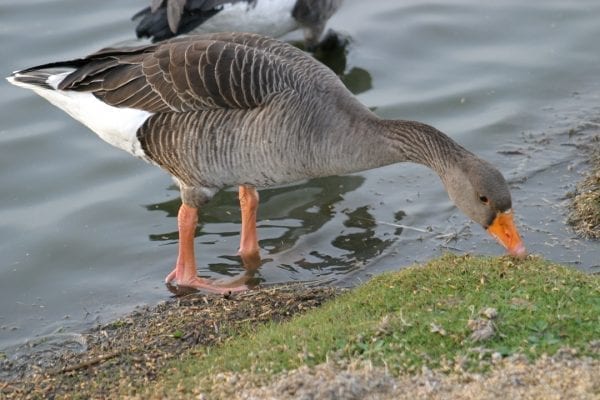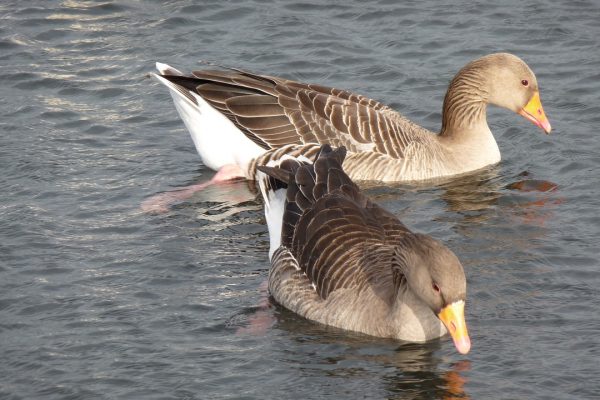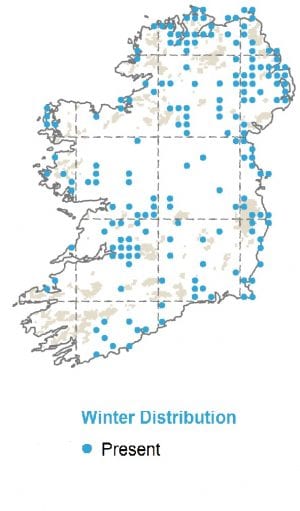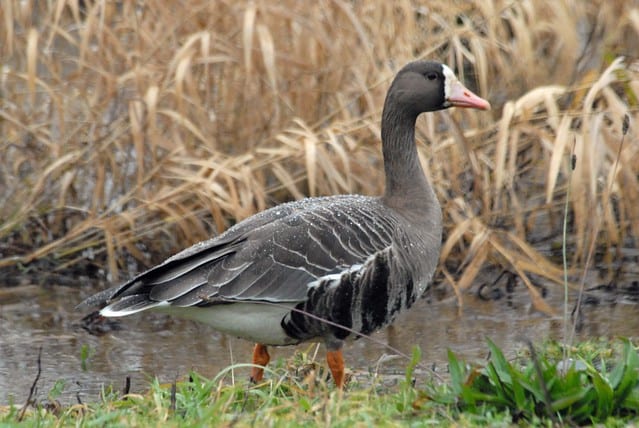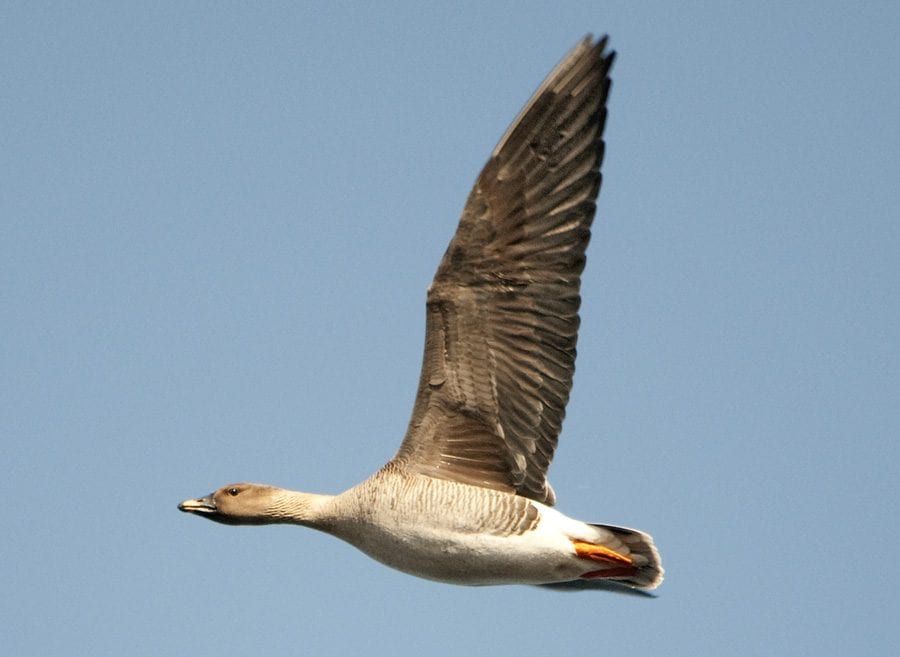
Greylag Goose
| Irish Name: | Gé Ghlas |
| Scientific name: | Anser anser |
| Bird Family: | Geese |
amber
Conservation status
Conservation status
Status
Winter migrant, with Icelandic birds between November & April. Feral birds are present year round.
Identification
Large bulky grey goose, with pinkish-orange bill and dull pink legs. Plumage is plain grey/brown. Some with thin white rim at the base of the bill, and many with dark marks on the belly.
Voice
Nasal cackling noise, trisyllabic, with the first higher pitched.
Diet
Greylag Geese used to concentrate more on estuaries, where they fed on the roots of rushes and sedges. Arable farming in Scotland increased during the post-war years, and appeared to coincide with increasing numbers of Greylag Geese switching to feed on arable farmland. Greylag Geese currently feed mostly on cereal stubble and grassland in their wintering areas.
Breeding
Breeds by lakes and reservoirs, with the nest site often close to water and hidden in reeds or other waterside vegetation. Nests in pairs, but locally colonially.
Wintering
The Icelandic population winters in Scotland and Ireland, occurring mostly at coastal sites. Highly gregarious.
Monitored by
Irish Wetland Bird Survey (I-WeBS). Annual census also carried out in November each season.
Blog posts about this bird

Launch of 45th edition of Irish Birds
The status of Greylag Geese in the Republic of Ireland, mapping of farmland bird hotspots and wintering waterbird trends in Ireland are just some of the many topics covered in the latest edition of Irish Birds.
Published in September 2023, the 45th edition of Ireland’s only ornithological journal is now available for purchase from the BirdWatch Ireland shop and would make the perfect gift for anyone with an interest in birds in Ireland and the latest research in the field of ornithology.
The latest edition of Irish Birds includes an overview of site-level and national trends for 35 wintering waterbird species at the 97 Irish Wetland Bird Survey sites. Across all sites analysed between 1994/95 and 2019/2020, Pochard, Scaup, Goldeneye, Golden Plover, Grey Plover and Lapwing showed large declines of over 50%, while Dunlin and Curlew showed moderate declines. 12 species underwent intermediate declines and the remaining 15 species were stable/ increasing. Further research to determine the drivers of these increases and declines is crucial and will help to shape future conservation efforts.
Farmland birds are one of the most threatened species groups in Europe and many studies have highlighted the declines in population and range of farmland birds in Ireland, the UK and across Europe. The declines, which are affecting sub-groups such as breeding waders and other ground-nesting birds in particular, are attributed to habitat loss and fragmentation, agricultural intensification, land drainage, afforestation and increases in predation. Recognising the important role that agri-environment schemes play in protecting and supporting farmland birds, BirdWatch Ireland has developed a series of maps which illustrate Irish hotspots for 28 species, including Curlew, Lapwing and Yellowhammer. These maps and the methods behind them are included and discussed in another paper – ‘Mapping of Farmland Bird Hotspots: a method to assist targeting of agri-environment measures’ – in the latest edition of Irish Birds.
An assessment of the status Greylag Geese in Ireland during the winter from 2017/18 to 2019/20 showed that the Icelandic population has declined by 42% since the previous assessment in 2007/08. This figure coincides with a c. 45% decline in the flyway population over the same period. Despite these population declines, the distribution of Icelandic Greylag Geese has remained unchanged in the Republic of Ireland over the last 10-12 years, with its concentration being in the eastern half of the country. Meanwhile, the feral population of Irish-breeding Greylag Geese is estimated to have increased by between 109 and 147% since 2008. This study, which was conducted by BirdWatch Ireland in collaboration with the National Parks and Wildlife Service (NPWS), can be read in Irish Birds. To conclude, this paper offers recommendations on how monitoring of Greylag Geese can be expanded upon and improved to help to increase our understanding of this species in Ireland.
Another incredibly informative read is a review paper that looks at the status of birds in County Cork. This paper is a summary of the incredibly detailed book, The Birds of County Cork, by Patrick Smiddy, Mark Shorten and Russ Heselden, which provides a comprehensive account of the ecology of all species known to have occurred in Cork from the earliest times to the present.
Notes on topics such as trichomonosis in finch species and nocturnal migration are some of the other interesting things that owners of Irish Birds can delve into.
The journal also includes a book of abstracts from the 2023 Ornithological Research Conference at University College Cork (UCC) and the Irish Rare Birds Report 2021. The latter is published on behalf of the Irish Rare Birds Committee (IRBC) – a group operating under the auspices of BirdWatch Ireland that is responsible for maintaining a list of the birds recorded in the Republic of Ireland, along with “at sea” records. The Irish Ringing Report 2021, which summarises birds ringed and caught in Ireland in 2021, is also included in the latest Irish Birds. There were many unusual discoveries, including a Kingfisher found in Tallaght which was previously sighted in East Sussex earlier in the year. Such long-distance movements of Kingfishers, especially overseas, are rare. There are also numerous examples of birds that reached a high age, including a Great Tit that was just one month shy of the British Trust for Ornithology (BTO) longevity record of 10 years 5 months and 18 days when it was re-trapped in Edenderry in 2021.
As the number one ornithological journal in Ireland, Irish Birds is a necessity for all serious birdwatchers and scientists working in the Irish conservation sector. The 45th edition of Irish Birds is now available from the BirdWatch Ireland shop, both online and in Kilcoole. Should you choose to support BirdWatch Ireland as a key member, you will receive a copy in addition to three copies of our membership magazine, Wings, every year.
Also, for those seeking previous issues, we have plenty of back issues of Irish Birds available at a reduced price. Whether you are keen to complete a collection or simply have a particular interest in a certain year or study, you can contact us to find out more about purchasing back issues.

BirdWatch Ireland urge people to report any signs of bird flu in their area
A number of cases of Avian Influenza (‘bird flu’) have been confirmed in wild birds in Ireland since the start of the month. There are no known risks to human health, and similarly this isn’t going to affect your garden birds, but please watch out for sick or dead waterbirds, birds of prey, or potentially large numbers of dead crows or starlings which may have died as a result of this virus. If you find any such birds, don’t touch them, but rather report them immediately to the Department of Agriculture via the link below. It is important that any potential cases of avian influenza are investigated and documented appropriately in order to monitor the spread of the virus.
Report any dead or sick waterbirds or birds of prey here.
There are numerous strains and subtypes of the avian influenza virus that each vary in severity. The strain that has recently been detected in some wild birds in Ireland is Highly Pathogenic Avian Influenza (HPAI) H5N1, which spreads easily between birds and causes illness, with a high death rate. This strain had been detected in a number of European countries before arriving into Ireland this month as wild birds migrate southwards and westwards for the winter. BirdWatch Ireland are part of an early warning system with regard to surveillance for signs of disease in wild birds, together with colleagues in the National Parks and Wildlife Service (NPWS), the Department of Agriculture, Food and the Marine and the National Association of Regional Game Councils (NAGC). What is the current situation with regards Avian Influenza in the Republic of Ireland? To date there have been confirmed mortalities from the H5N1 strain of highly pathogenic avian influenza in counties Galway, Roscommon, Offaly, Donegal and Kerry, with further cases under investigation in other counties. The birds known to have been infected so far are Whooper Swans, Greylag Geese, Peregrine Falcons and a White-tailed Eagle. In winter, waterbirds of a range of different species congregate together at wetlands across the country, which allows the virus to spread easily amongst waterbird flocks and between species. When these birds become sick, they are easy prey for raptors such as Peregrines and Eagles, hence these species are often infected also. What are the signs to watch out for? Firstly, it’s important to be aware that the only wild birds expected to become infected at present are waterbird species (wildfowl, waders, gulls) and birds of prey. If you own chickens or other poultry then please consult the Department of Agriculture website for further advice. If you find a dead waterbird of bird of prey, where the cause of death isn’t obvious (e.g. car collision) then it’s best to report it to the Department of Agriculture, so it can be collected and tested. If you find a bird of these species that’s acting unwell or otherwise behaving strangely, then this too should be reported. It’s important to note that potentially sick birds should not be brought to a wildlife rehabilitator or the National Wildlife Hospital in Meath, as this could risk infecting the birds already in their care. If you find a sick bird, report it via this link first, and secondly you may want to call the Avian Influenza Hotline (01 6072512 during office hours or 01 4928026 outside office hours). Should I stop feeding my garden birds? Although it is possible for garden bird species to get bird flu, they are at very low risk at present, for the simple reason that they don’t interact with the species currently infected (i.e. waterbirds). As such, there is no reason to stop feeding your garden birds. If the situation deteriorates and this advice changes, we will spread the word and ensure everyone knows. What should I do if I own poultry? To date there have been no cases in poultry flocks in Ireland, but poultry owners should familiarise themselves with Department of Agriculture guidance on biosecurity and the new regulations introduced as a precautionary measure. It should be stressed that there is no food safety risk for consumers and that properly cooked poultry and poultry products are safe to eat. What is the situation in Northern Ireland? Full details on restrictions for poultry flock owners, and where to report possible cases in wild birds in Northern Ireland, can be found on the DAERA website here. Further information and updates are regularly made available on the Department of Agriculture website:https://www.gov.ie/en/publication/50ce4-avian-influenza-bird-flu/

